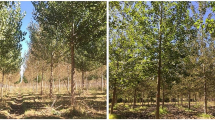Abstract
Landsat TM images were obtained of blight damage to a Japanese red pine forest in the western part of Hiroshima Prefecture, Japan, using a spectral vegetation index; that is, the ratio of the digital number (relative reflectance on the ground surface) of TM Band 4 to Band 3 observed in May 1987, which decreased with the increase in the canopy cover of damaged pine trees measured in the field. The TM images suggested that the areas of damaged forest were concentrated in or near cities, industrial areas and expressways. The correlation between forest damage and environmental factors (air pollution and urban development) around the pine forest was therefore analysed by overlaying the blight damage with the proportion of developed areas obtained from TM data or mesh data of air pollution. The results of analysis indicated a significant correlation between forest damage and environmental factors, and showed that these two environmental factors made nearly equal contributions to the blight damage in the pine forest. This suggests that urban development and air pollution may affect the physiology of pine trees and promote blight by reducing the resistance of trees to the pinewood nematode.
Similar content being viewed by others
References
Futani K. &Harashima S. (1990) Effect of simulated acid mist on pine wilt disease.J. Jpn. For. Soc. 72: 520–3 (in Japanese with English summary).
Hiroshima Prefectural Government (1989) Report of environmental information guide in Hiroshima Prefecture. 191 pp. Hiroshima Prefecture (in Japanese).
Higashi T. (1990) Extraction of expanded area of damaged stands by pine wilt disease using two Landsat TM data.Remo. Sens. Soc. Jpn. 10: 389–95 (in Japanese).
Kiyohara T. &Tokushige Y. (1971) Inoculation experiments of a nematode.Bursaphelenchus sp. onto pine trees.J. Jpn. For. Soc. 53: 210–18 (in Japanese with English summary).
Morimoto K. &Iwasaki A. (1972) Role ofMonochamus alternatus (Coleoptera: Cerambycidae) as a vector ofBursaphelenchus lignicolus (Nematode: Aphelenchoididae.J. Jpn. For. Soc. 54: 177–83 (in Japanese with English summary).
Mukai Y., Sugimura T., Watanabe H. &Wakamori K. (1984). Extration of damaged area by pine beetle using Landsat MSS data.J. Remo. Sens. Soc. Jpn. 4: 125–35 (in Japanese with English summary).
Nakane K., Matsushita K., Mifune M. &Mtsudera M. (1985) High speed processing and easy operation system for analyzing Landsat MSS data using personal computer.J. Remo. Sens. Soc. Jpn. 5: 57–67 (in Japanese with English summary).
Nakane K., Yakuta K. &Nehira K. (1986) Assessment of degree of the damage by forest fire based on Landsat MSS data: A case of the Miyajima Island, Hiroshima, Japan.J. Remo. Sens. Soc. Jpn. 6: 349–57 (in Japanse with English summary).
Okuda T. &Nakane K. (1988) Application of Landsat MSS data to the vegetation classification—A case of the northwestern part of Fukuoka Prefecture, Japan.Jpn. J. Ecol. 38: 85–97 (in Japanese with English summary).
Sellers P. J. (1989) Vegetation-canopy, spectral reflectance and biophysical processes. In:Theory and Application of Optical Remote Sensing (ed G. Asrar), pp. 297–428. John Wiley, New York.
Senoo T. &Honjyo T. (1988) Assessment of tree stress by airborne multi-spectral scanning data.J. Jpn. For. Soc. 70: 45–56.
Tanaka K. (1975) Effects of SO2 on occurrence of pine wilt disease.Trans. Meet. Jpn. For. Soc. 86: 287–9 (in Japanese).
Tokushige Y. &Kiyohara T. (1969)Barsaphelenchus sp. in the wood of dead pine tree.J. Jpn. For. Soc. 51: 57–67 (in Japanese).
Toyohara G. (1987) Relationship between the blight of pine trees and vegetation. In:Ecological Studies in the Environmental Effects of Insecticides on the Pine Forest Ecosystem, Particularly the Change of the Pine Forest Ecosystem Caused by the Pine Wood Disease (ed. Nature Conserv. Soc. Japan), pp. 226–33. Nature Conserv. Soc. Japan, Tokyo (in Japanese).
Author information
Authors and Affiliations
About this article
Cite this article
Nakane, K., Kimura, Y. Assessment of pine forest damage by blight based on Landsat TM data and correlation with environmental factors. Ecol. Res. 7, 9–18 (1992). https://doi.org/10.1007/BF02348592
Issue Date:
DOI: https://doi.org/10.1007/BF02348592




